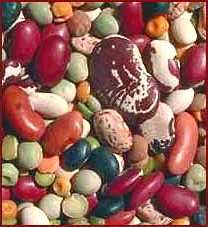
Additionally, legumes have been known to help lower cholesterol levels and improve the control of blood glucose levels in diabetics as their high fiber level allows them the ability to release their sugars slowly and steadily. They have also been credited in reducing the risk of some types of cancer.
Since legumes contain the same number of calories as grains and supply two to four times as much protein in those calories, they are a most helpful food in weight reduction. When combined with grains they form a complete protein.
The one problem with beans, which has thwarted their reputation as a romantic food, is the flatulence they cause due primarily to the oligosaccharide found in them. Oligosaccharide is a carbohydrate composed of three to five sugar molecules linked together in such a way that the body cannot digest or absorb them. They therefore pass into the intestines and are broken down by bacteria which in turn produces gas. This problem can be reduced significantly by proper preparation and cooking.
Many species
The fossil record shows that legumes, part of the vegetable family, are among the oldest of cultivated plants. In having domesticated over 13,000 species, there is a wide variety to choose from; but there is one bean that is beginning to draw a lot of interest from today's culture. The little known tepary bean, after having become forgotten and almost extinct, is making a comeback.
The tepary had at one time been domesticated as a staple food for Native Americans, the Tohono O'odham, of the Sonoran Desert. Its name was derived from the desert pharse 't'pawi' which means, 'it's a bean,' and has since been called a variety of names such as pawi, pavi, escomite, yori mui, and yori muni.'
The beans vary in color and shape; they are oval, flattish, or round and come in colors of off-white, speckled brown, reddish-brown, or purplish-brown. Since they are very small, they are a quick crop yield, but their thin skins make them very difficult to harvest as they are prone to split open and scatter upon touch.
The rediscovery of their unique and nutty sweet flavor is proving a delight in many exotic and exciting recipe dishes. They lend themselves well to almost any recipe in which more common beans are specified making them an easy and delightful experiment in salads, soups, stews, bean dip, tortillas, chili, hummus, and even lasagna. It's also nice to know that their low polyunsaturated fat content makes them easier to digest than other beans.













No comments:
Post a Comment